Frizzy Hair Meaning, Characteristics, and Management
Updated on
This post may contain affiliate links. As an Amazon Associate, we may earn from qualifying purchases.
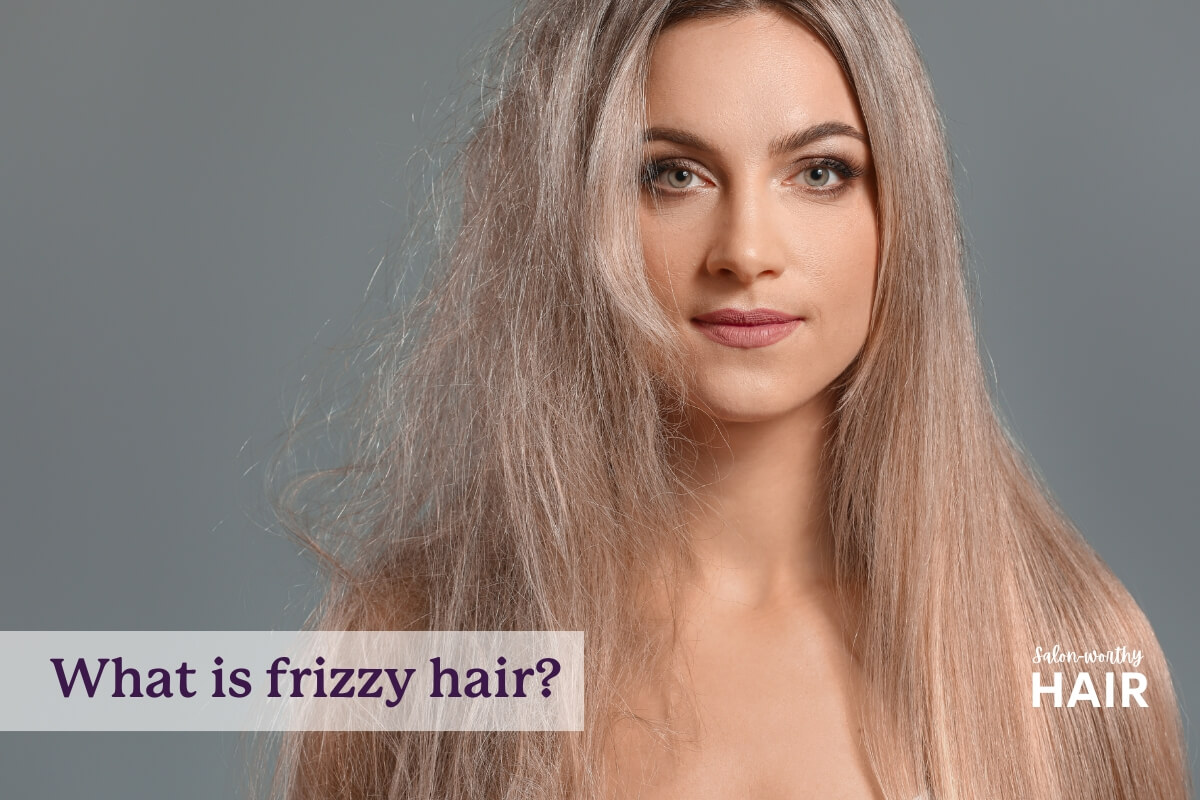
Frizz is hair that does not align with the general pattern of the rest of the hair.
Frizzy hair stands up or curls on its own to create an irregular or fuzzy texture. It creates inconsistent patterns and textures in the main body of the hair instead of clumping uniformly into a cohesive and smooth hairstyle. As a result, frizzy hair is unpredictable and difficult to control.
Frizz is the opposite of smooth hair. It has an uneven, rough, bumpy, and irregular texture because of its raised and uneven cuticle layer. The cuticle layer, the outermost protective layer of the hair shaft, plays a crucial role in maintaining the hair shaft’s smooth and flat exterior. When frizz occurs, the cuticle cells become raised, contributing to the rough texture of the hair fiber.
When the cuticle cells cannot lie flat and smooth, some gaps and holes allow moisture to escape from the hair strands, leading to dehydration and dryness. Dryness makes the hair less elastic, meaning it loses its ability to stretch and bend, making it more stubborn and resistant to styling efforts.
Frizz, however, is not exclusive to dry hair. Other conditions, such as uneven hair lengths due to new growths or haircuts, excessive use of styling products and tools, environmental conditions like humidity, can all lead to hair that appears unruly and difficult to manage.
To manage and reduce frizz effectively, it’s important to understand the root causes, starting from your hair type and condition to evaluating the products you use in your haircare routine.
What Does Frizzy Hair Mean?
Frizzy hair means hair that sticks out or curls up unpredictably in multiple directions, causing an inconsistent and disorganized texture that does not align with most of the hair’s natural direction, pattern, or style.
Frizzy hair disrupts the overall uniformity of the hairstyle.
More: Frizzy Hair 101 – The Complete Guide to Managing Frizz.
What Does Frizz Look Like?
Frizzy hair looks untidy, unruly, frazzled, frayed, fluffy, fuzzy, damaged, or can be anything in between.
The photo below shows what frizz looks like:
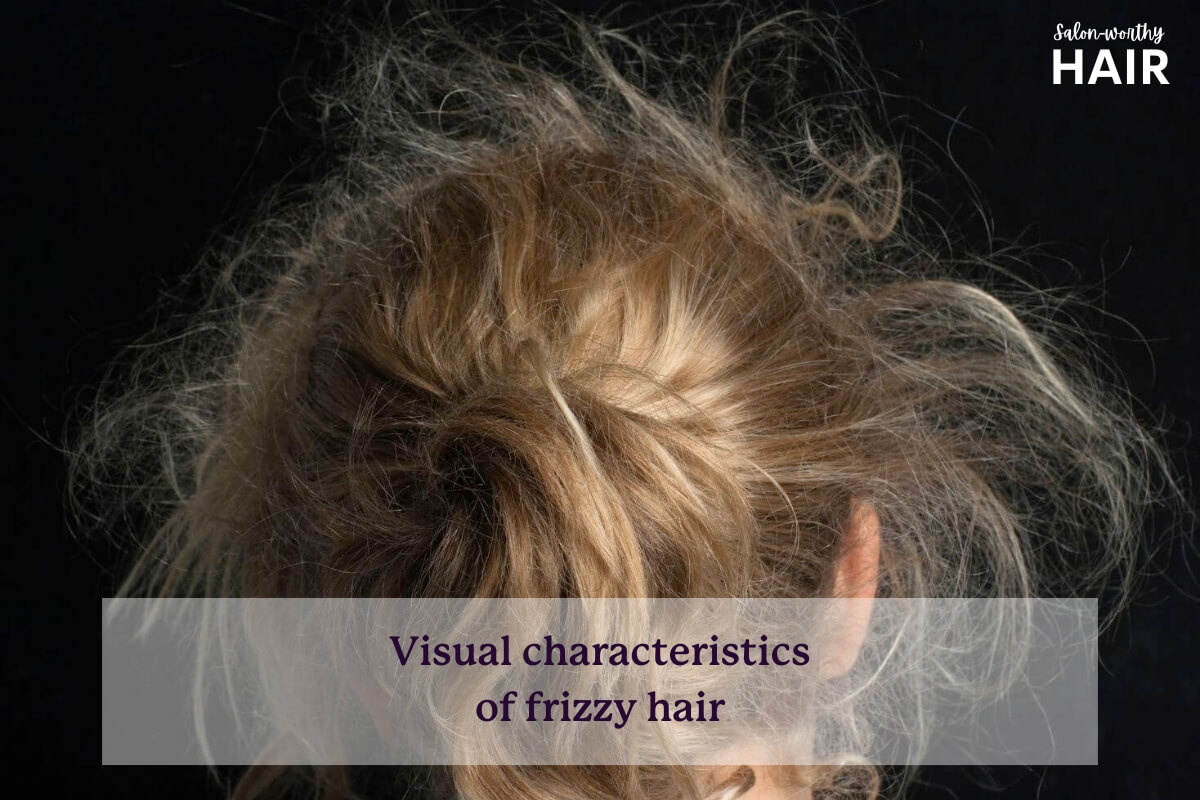
The appearance and degree of frizz can significantly vary among individuals, influenced by the characteristics of their hair and its overall health. For instance, someone with straight hair may experience frizz as individual strands stick out, creating a flyaway or static-like appearance. On the other hand, people with curly hair might see their frizz as an increase in hair volume or puffiness, with less defined curl patterns.
Does Frizzy Hair Mean Dry Hair?
Frizz and dryness are often related but not identical or mutually exclusive.
“Hair dryness” is characterized by a parched and brittle texture caused by a persistent lack of hydration in individual hair strands. Excessive heat styling, frequent washing with sulfate-based shampoos, chemical treatments, and exposure to environmental elements like the sun, wind, and dry and cold weather can all deplete the hair’s natural oils and moisture, making it can feel straw-like and lackluster in appearance.
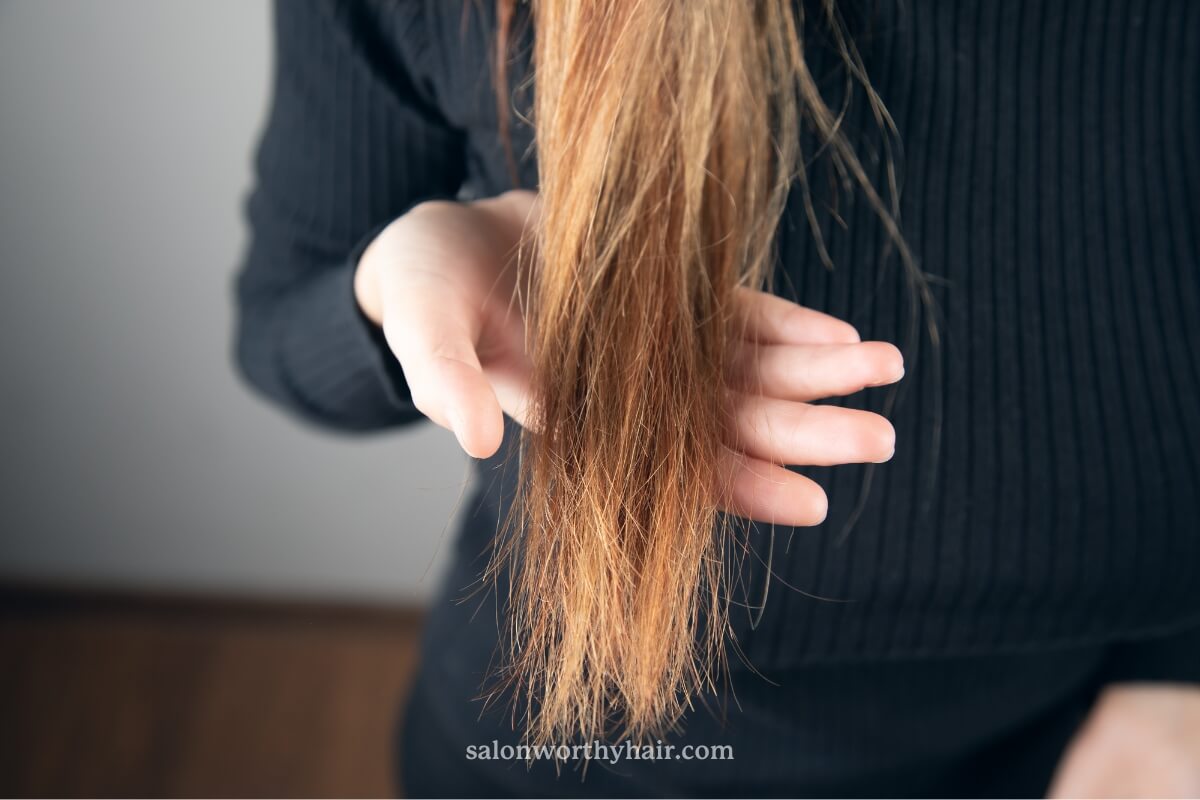
Frizz means hair with an unruly appearance and stray strands that stand out from the rest.
While frizziness can be related to factors like dryness, it may also be influenced by other aspects such as the hair’s health condition, weather conditions, haircare routines, or the hair’s genetic characteristics. For instance, frizz is more pronounced in curly and natural hair, especially in humid weather, regardless of the hydration level.
What Does Frizzy Natural Hair Mean?
Frizzy natural hair refers to afro-textured hair, like curly, coily, and kinky hair. These hair types have a distinctive coarse and rough feel and tend to exhibit dryness, puffiness, and a lack of shape when left in their natural, unstyled condition. This type of frizz is particularly prevalent in individuals with curly and kinky hair types, encompassing a range from 3A to 4C hair types, especially when they are not adequately moisturized.
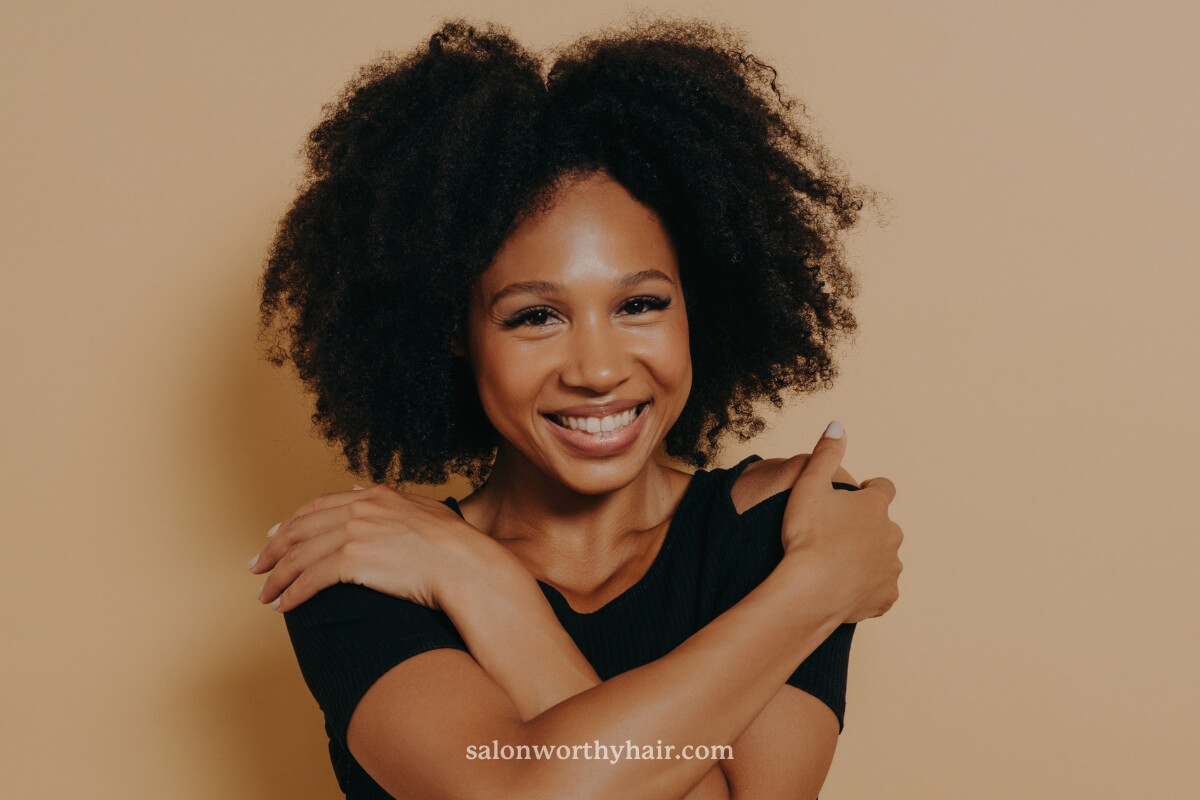
The unique structure of curly and kinky hair lies in its twisted follicles, resulting in hair strands that appear frizzy when they lack sufficient moisture. Without proper hydration, these hair types can become prone to frizz due to their inherent porosity, which makes them susceptible to losing moisture easily. The cuticles of curly and kinky hair are more open and lifted than straight hair, allowing moisture to escape more readily, leading to characteristic dryness and unruly frizz.
Afro-textured hair often has high porosity, meaning it has more holes and spaces on the cuticle layer. High porosity makes the hair absorb moisture from a humid environment. As a result, frizz becomes more noticeable and pronounced as the hair fiber swells from the excess moisture, causing the strands to take on a voluminous appearance.
Does Frizzy Hair Hair Mean Fluffy Hair?
No, fluffy hair does not necessarily mean frizzy hair, although the two can sometimes overlap.
Fluffy hair is generally used to describe hair with a larger volume or fluffiness, often due to its natural shape, density, thickness, or the presence of a certain humidity level. It is typically associated with hair types that naturally have more volume, like curly and wavy hair. Fluffy hair can be desirable for some who seek a more voluminous hairstyle.
Fluffy hair and frizz in hair are often misunderstood due to the interplay of volume, density, and moisture. While both fluffy and frizzy hair shares the characteristic of increased volume, fluffy hair generally implies a desirable, voluminous hairstyle.
Does Frizzy Hair Mean Curly Hair?
Frizzy hair and curly hair are not the same because they have distinct characteristics. Curly hair is defined by its natural curl pattern, while frizzy hair is defined by its lack of control and manageability.
In curly hair, the shape of the follicles, the small tube-like structures in the skin from which individual hairs grow, determines the curl pattern, and the pattern can range from loose waves to tight coils, depending on an individual’s hair type (e.g., Type 2A to Type 4C).
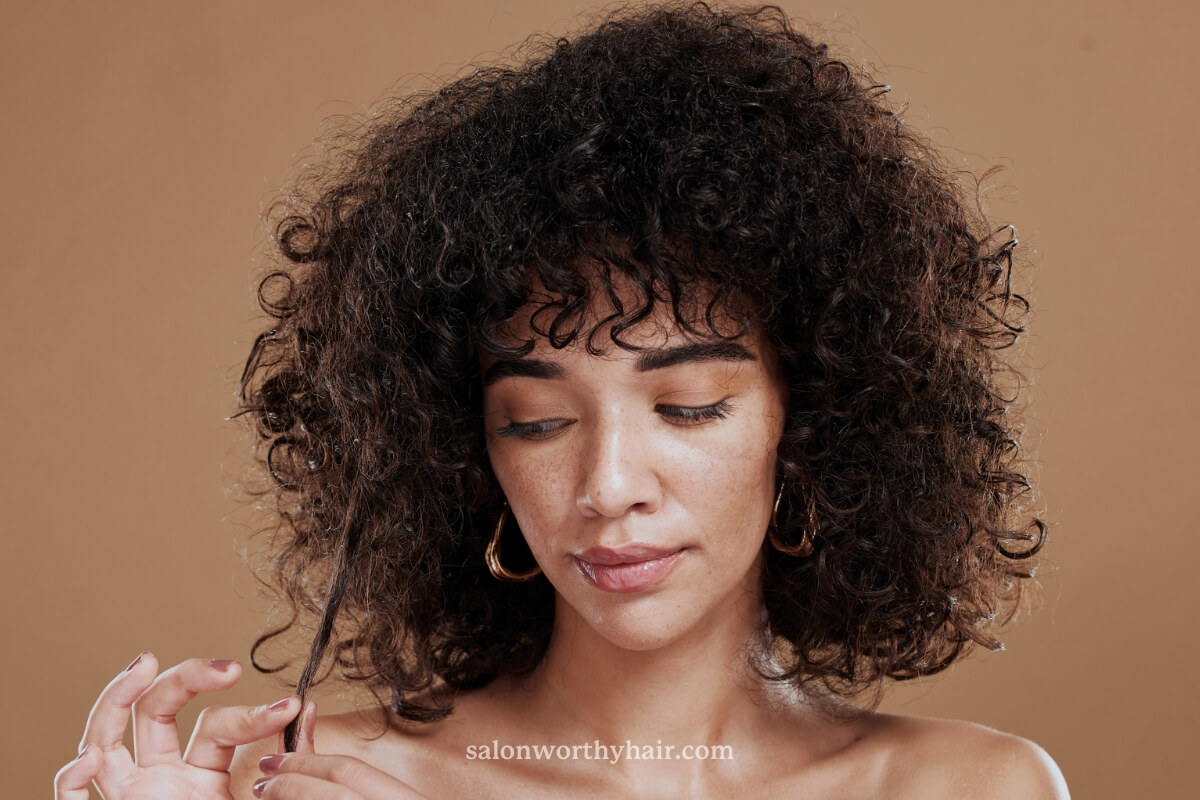
Frizzy hair, on the other hand, is not dependent on the follicle shape. Frizz affects hair that has already grown out of the scalp.
Although frizzy hair and curly hair have different characteristics, they can be related. People with curly hair may experience frizz, especially when their hair lacks proper moisture and hydration. However, not all curly-haired individuals have frizz, and not all frizzy hair is curly.
The amount of frizz depends on the curl type and hair health. Tighter curl patterns, like 3B or 4C hair, are more prone to pronounced frizz. Type 2 hair (wavy) can also experience frizz, but it tends to be less prominent than tighter curl patterns.
Read more: Why curly hair gets frizzy?
Can Wavy Hair Be Frizzy?
Yes, wavy hair can be frizzy. Frizz may appear as minor disruptions in the wave pattern or as small flyaway hairs, making the hair look less smooth and more unruly.
Wavy hair (type 2) falls between straight and curly hair with a loose curl pattern, like waves, that are larger than tight curls. The wave patterns can range from barely-there to more defined.
Can Straight Hair Be Frizzy?
Straight hair can be frizzy due to humidity, styling (brushing), haircare routines, and product-related factors despite its natural smoothness.
Straight hair (type 1) has a flat and smooth texture, flowing directly from the root to the tip without any visible bends. Straight hair grows vertically without any curl or bend to it. It has a uniform alignment, providing a naturally sleek and shiny appearance.
However, despite its straightness and smoothness, straight hair is not immune to “frizz.” Lack of hydration and mechanical friction caused by brushing and styling can disrupt the hair’s cuticle layer, leading to frizz in the form of flyaways around the hairline and face.
Does Flyaway Hair Mean Frizz?
Flyaway hair can be a sign of frizz, but not always.
Flyaways are fine and wispy hair strands that stand out from the main body of the hair. In contrast, frizz refers to the dry and coarse texture of the hair strands, often with slightly lifted cuticle cells. While both flyaways and frizz in hair may have a similar effect, they have different causes and require different targeted treatments.
Read more: Differences between frizz and flyaways.
Does New Hair Growth Give Frizzy Hair Appearance?
New hair growth can give a temporary frizzy hair appearance.
When new hairs emerge from the scalp, they lack shape, length, maturity, and smoothness as they are not fully developed. These new strands are often shorter than the rest of the hair and might not fall in line with the longer, established hair. As a result, the virgin hairs stick out amongst the rest, giving an overall frizzy look.
The new hairs themselves tend to be curlier and rougher than mature hairs. They have not yet been weathered and conditioned by regular washing, styling, and environmental factors. Their cuticle layers are also rough, causing them to lack smoothness.
New hair growth occurs gradually across the scalp. So there may be patches or strands of shorter, frizzier new growths mixed with longer, smoother mature hairs. This uneven mix of hair maturity and lengths contributes to an unruly, frizzy appearance.
Over time, as the new hairs mature and are cared for, they align with the rest of the hair. So frizz from new growths is often a temporary phase that subsides as the new baby hairs reach equal lengths.
Does Frizzy Hair Mean Damaged Hair?
While frizzy and damaged hair can both exhibit coarse texture, dullness, dryness, lack of smoothness, and styling difficulties, they are not the same. The key difference is the physical condition of the hair’s cuticle layer. Frizz often implies raised but intact cuticles, while damage means compromised or weakened cuticles.
Damaged hair is a condition where the hair’s cuticle is harmed or weakened. Normally, these cuticles lie flat and smooth. Once compromised, the hair fiber’s interior structures become exposed, making them more susceptible to breakage. Consequently, this condition can exhibit signs of frizz and become prone to split ends.
Frizz is when a certain portion of someone’s hair strands do not align consistently, instead pointing in various directions. This misalignment of strands may result in the hair appearing frizzy.
In essence, frizz is not a direct indicator of damage but rather a visual manifestation of misaligned hair strands.
Does Frizzy Hair Mean Split Ends?
Frizz does not mean split ends because split ends occur at the ends of the hair, whereas frizz can affect the entire hair length.
Split ends, scientifically known as “trichoptilosis,” is a term used to describe the splitting or fraying of the hair shaft at the ends. The split can divide into two or more parts and travel further up the hair shaft, causing hair breakage.
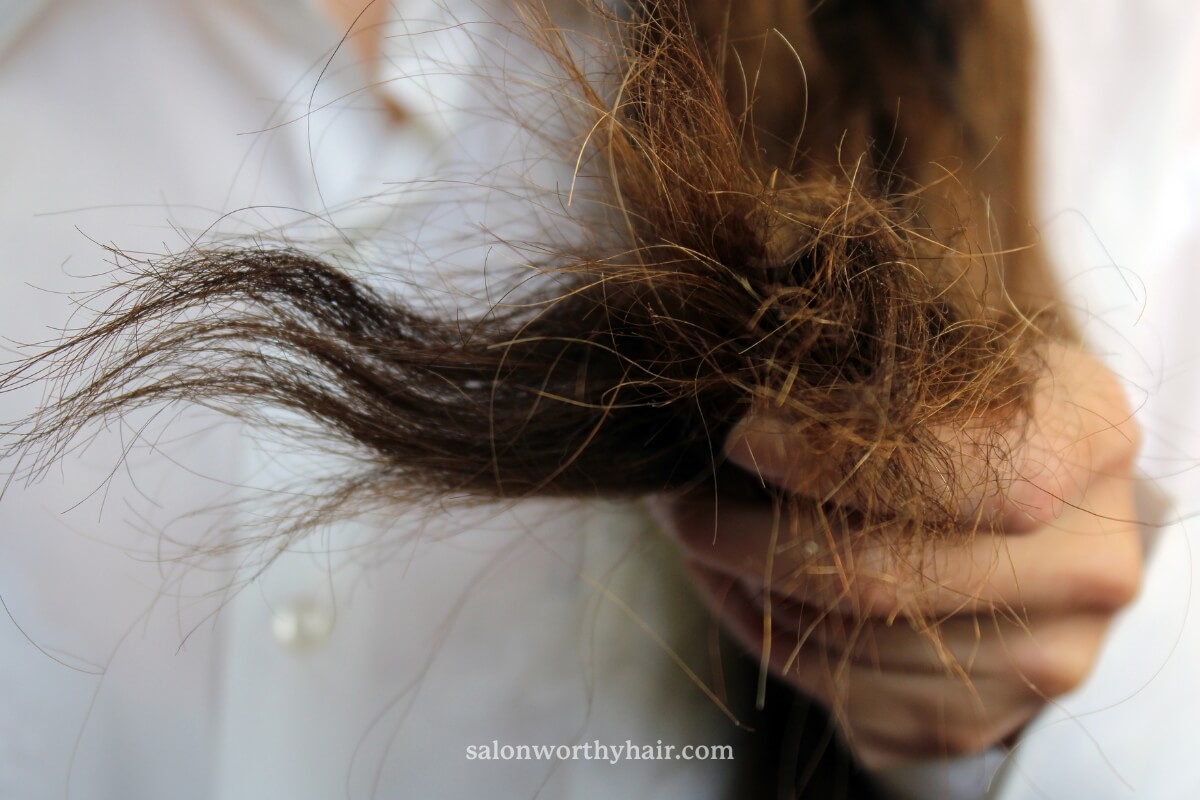
While split ends can contribute to the appearance of frizz, it is possible to experience frizziness without split ends. For example, hair naturally sensitive to humidity can frizz up even if there are no signs of split ends.
For those with long hair, split ends become even more problematic. Longer locks are older, weaker, and have had prolonged exposure to damage from styling. The ends are far from the scalp’s nourishing oils (sebum). This combination makes it very prone to dryness and splitting.
Does Long Hair Contribute to Frizziness?
Frizz is more likely to occur in long hair than in short hair because of its age, moisture distribution, and increased handling. The ends of long hair, being older, have had more exposure to environmental elements like sun, wind, humidity, and water, resulting in more wear and tear. It can be harder for the scalp’s natural oil (sebum) to travel down the entire length of the strand, so the ends can become dry. Longer hair also requires more styling and handling, which can further increase the chances of frizziness.
Long hair extends well beyond the shoulders. The length can vary greatly from person to person, ranging from just past the shoulders to mid-back, waist-length, or even longer. For some, it may reach as far down as the waist or hips. The defining characteristic of long hair is that it has been grown out over a significant period, often years.
The length, especially towards the ends, naturally undergoes more wear and tear from environmental exposure, heat styling, and daily grooming practices. The wear and tear can degrade the protective outer cuticle layer of the hair shaft over time, causing frizz.
Keeping the hair short makes it less vulnerable to frizz and easier to manage.
Is Short Hair Prone to Frizz?
Short hair is less prone to frizz compared to longer hair.
Short hair falls at shoulder-length or shorter. The length can vary from buzz cuts and pixie cuts to bob hairstyles. Short hair barely reaches past the nape of the neck, staying close to the contours of the head.
Short hair is easier to manage and maintain than longer hair because it has less surface area and less cumulative exposure to damage from styling, sun, and brushing. Shorter strands are lighter and closer to the scalp’s natural oils; therefore, they get more of the scalp’s natural oils to stay moisturized.
Shorter hair is compact, defined, and clump together naturally rather than frizzing out individually. The natural pattern is better maintained.
The shorter the cut, the less potential there is for frizz.
Short haircuts are less susceptible to split ends, tension, and weathering that degrade hair cuticles and lead to frizz. The shorter the style, the more manageable the hair is.
Does Frizzy Hair Mean Unmanageable Hair?
Frizz makes hair more challenging to manage but not impossible.
Frizz can be managed by anti-frizz products, conditioning, and styling to prevent individual strands from becoming unruly.
Lack of control and manageability is often due to the hair’s clumping, volume, damage, or dryness. Unmanageable hair resists staying smoothed down and tends to have a disheveled, messy look no matter what products or techniques are used on it.
In contrast, hair that is considered manageable is easy to control, style, and keep orderly. It can hold hairdos and hairstyles without constant reworking.
Frizz makes hair unmanageable due to a lack of clumping and definition. But other traits like curl pattern, density, and porosity can also lead to unruly hair.
Does Frizzy Hair Mean Unruly Hair?
Yes, frizzy hair means unruly hair.
Unruly hair is a term used to describe hair that does not easily conform to a desired style or shape. It means hair that is wild, disobedient, and resistant to being tamed or controlled. It tends to create a messy look as strands go every which way. Unruly hair can be challenging to straighten, prone to tangling, or resistant to holding a particular hairstyle.
Frizzy hair fits this definition well. Frizzy hair is defiant to styling efforts. Frizzy strands do not cling together in neat, defined clumps. Instead, they splay out in all directions creating a fuzzy, frizzy appearance. Frizzy hair bounces back out of place at the slightest provocation, creating a messy, uncontrolled look.
To effectively manage and lessen frizz, it is essential to identify the root causes before searching for treatments. That’s because there is no one-size-fits-all solution to frizz. Everyone’s frizz might be related to different causes. Some people may have naturally prone-to-frizz hair, while others may experience frizz due to their haircare routines.
What Causes Frizzy Hair?
Frizz is primarily caused by a raised cuticle layer and lack of moisture. Factors such as humidity, heat styling tools, chemical treatments, poor haircare routines, and genetics can exacerbate the frizziness. These elements cause the hair cuticles to lift, allowing moisture to pass through and swell the strands, leading to a frizzy appearance.
Read more: Causes of frizzy hair.
How to Make Hair Less Frizzy?
A strategic haircare routine that includes anti frizz treatments and frizz control products is essential to reduce frizziness. Anti frizz treatments are specialized haircare methods designed to manage and reduce frizz. These methods include using hydrating products and minimizing heat styling tools like blow dryers, hair straighteners, and hair curling irons.
Frizz control products include moisturizing shampoos and conditioners, deep-conditioning treatments or masks, leave-in conditioners, and anti-frizz serums.
In addition to adopting a suitable haircare routine, making certain lifestyle changes can significantly contribute to reducing frizz. Regular trims, not washing hair with hot water, air drying, sleeping on a silk pillowcase, staying hydrated, and eating a healthy diet can improve healthy growth and reduce frizz.
Frizzy Hair is Unruly But Can Be Managed
Frizzy hair is difficult to tame and control but not impossible to manage.
Frizz can affect various hair types, including curly, straight, thick, and wavy. It is primarily caused by a raised cuticle layer, which allows moisture to escape from the hair strands, leading to dehydration and dryness. Different factors like haircuts, damaged hair, and humidity can also contribute to frizz.
Frizz can also prevail due to the hair’s inherent porosity and high sensitivity to moisture.
To manage frizz effectively, developing a tailored haircare routine that focuses on moisture and protection from damage is essential. By understanding the specific needs of your hair type and adopting suitable products and practices, you can control frizz and achieve a more defined, well-groomed hairstyle.
Remember that individual experiences with frizz may vary, and what works for one person may not work for another. Embrace your hair’s natural characteristics and experiment with different techniques to find the best approach to managing frizz or just embrace it.
About the Author
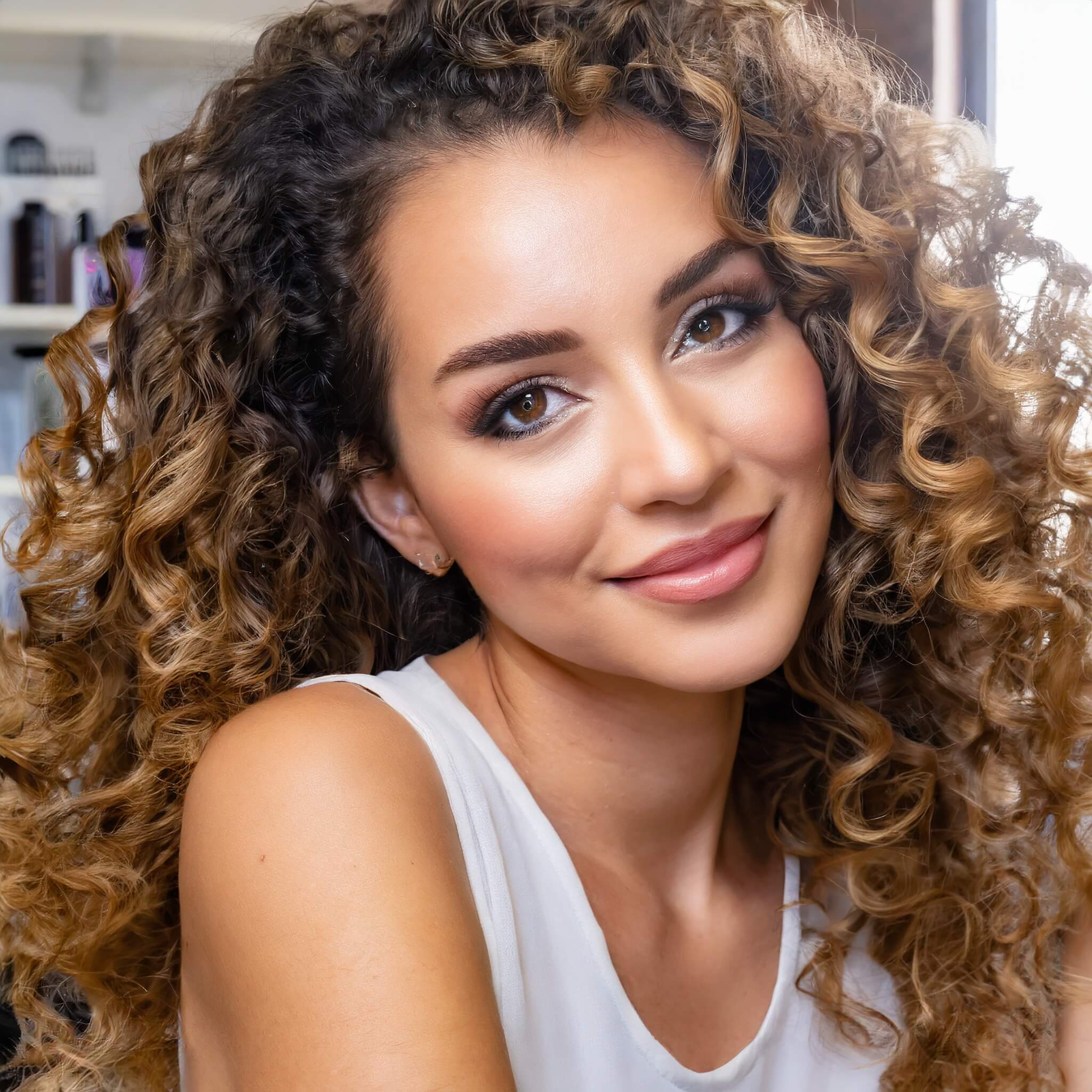 Camelia Smith
Camelia SmithCamelia Smith can color hair, perform keratin treatments, bleach hair, and even cut curly hair. She is our go-to person whenever we have hair treatments and styling questions.
She's also currently training as a freelance makeup artist and is passionate about helping others feel beautiful in their skin. When she's not writing or doing hair, she's usually spending time watching British period dramas.